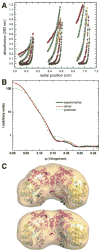Crystal structure of a bacterial phosphoglucomutase, an enzyme involved in the virulence of multiple human pathogens
- PMID: 21246636
- PMCID: PMC3066478
- DOI: 10.1002/prot.22957
Crystal structure of a bacterial phosphoglucomutase, an enzyme involved in the virulence of multiple human pathogens
Abstract
The crystal structure of the enzyme phosphoglucomutase from Salmonella typhimurium (StPGM) is reported at 1.7 A resolution. This is the first high-resolution structural characterization of a bacterial protein from this large enzyme family, which has a central role in metabolism and is also important to bacterial virulence and infectivity. A comparison of the active site of StPGM with that of other phosphoglucomutases reveals conserved residues that are likely involved in catalysis and ligand binding for the entire enzyme family. An alternate crystal form of StPGM and normal mode analysis give insights into conformational changes of the C-terminal domain that occur upon ligand binding. A novel observation from the StPGM structure is an apparent dimer in the asymmetric unit of the crystal, mediated largely through contacts in an N-terminal helix. Analytical ultracentrifugation and small-angle X-ray scattering confirm that StPGM forms a dimer in solution. Multiple sequence alignments and phylogenetic studies show that a distinct subset of bacterial PGMs share the signature dimerization helix, while other bacterial and eukaryotic PGMs are likely monomers. These structural, biochemical, and bioinformatic studies of StPGM provide insights into the large α-D-phosphohexomutase enzyme superfamily to which it belongs, and are also relevant to the design of inhibitors specific to the bacterial PGMs.
Copyright © 2010 Wiley-Liss, Inc.
Figures





Similar articles
-
Identification of an essential active-site residue in the α-D-phosphohexomutase enzyme superfamily.FEBS J. 2013 Jun;280(11):2622-32. doi: 10.1111/febs.12249. Epub 2013 Apr 8. FEBS J. 2013. PMID: 23517223
-
Quaternary structure, conformational variability and global motions of phosphoglucosamine mutase.FEBS J. 2011 Sep;278(18):3298-307. doi: 10.1111/j.1742-4658.2011.08246.x. Epub 2011 Aug 8. FEBS J. 2011. PMID: 21767345
-
Crystal structure of phosphoglucomutase from Leishmania major at 3.5 Å resolution.Biochimie. 2016 Feb;121:102-11. doi: 10.1016/j.biochi.2015.11.015. Epub 2015 Dec 1. Biochimie. 2016. PMID: 26607241
-
Structural and mechanistic investigations on Salmonella typhimurium acetate kinase (AckA): identification of a putative ligand binding pocket at the dimeric interface.BMC Struct Biol. 2012 Oct 2;12:24. doi: 10.1186/1472-6807-12-24. BMC Struct Biol. 2012. PMID: 23031654 Free PMC article.
-
Promotion of enzyme flexibility by dephosphorylation and coupling to the catalytic mechanism of a phosphohexomutase.J Biol Chem. 2014 Feb 21;289(8):4674-82. doi: 10.1074/jbc.M113.532226. Epub 2014 Jan 8. J Biol Chem. 2014. PMID: 24403075 Free PMC article.
Cited by
-
Sequence-structure relationships, expression profiles, and disease-associated mutations in the paralogs of phosphoglucomutase 1.PLoS One. 2017 Aug 24;12(8):e0183563. doi: 10.1371/journal.pone.0183563. eCollection 2017. PLoS One. 2017. PMID: 28837627 Free PMC article.
-
Normal Mode Analysis as a Routine Part of a Structural Investigation.Molecules. 2019 Sep 10;24(18):3293. doi: 10.3390/molecules24183293. Molecules. 2019. PMID: 31510014 Free PMC article. Review.
-
Functional screening of antibiotic resistance genes from a representative metagenomic library of food fermenting microbiota.Biomed Res Int. 2014;2014:290967. doi: 10.1155/2014/290967. Epub 2014 Aug 28. Biomed Res Int. 2014. PMID: 25243126 Free PMC article.
-
Glucose-1,6-Bisphosphate, a Key Metabolic Regulator, Is Synthesized by a Distinct Family of α-Phosphohexomutases Widely Distributed in Prokaryotes.mBio. 2022 Aug 30;13(4):e0146922. doi: 10.1128/mbio.01469-22. Epub 2022 Jul 20. mBio. 2022. PMID: 35856562 Free PMC article.
-
Bacillus subtilis PgcA moonlights as a phosphoglucosamine mutase in support of peptidoglycan synthesis.PLoS Genet. 2019 Oct 7;15(10):e1008434. doi: 10.1371/journal.pgen.1008434. eCollection 2019 Oct. PLoS Genet. 2019. PMID: 31589605 Free PMC article.
References
-
- Paterson GK, Cone DB, Peters SE, Maskell DJ. The enzyme phosphoglucomutase (Pgm) is required by Salmonella enterica serovar Typhimurium for O-antigen production, resistance to antimicrobial peptides and in vivo fitness. Microbiology. 2009;155(Part 10):3403–3410. - PubMed
-
- Bizzini A, Majcherczyk P, Beggah-Moller S, Soldo B, Entenza JM, Gaillard M, Moreillon P, Lazarevic V. Effects of alpha-phosphoglucomutase deficiency on cell wall properties and fitness in Streptococcus gordonii. Microbiology. 2007;153(Part 2):490–498. - PubMed
Publication types
MeSH terms
Substances
Grants and funding
LinkOut - more resources
Full Text Sources

